Top 5 Most Pervasive Carcinogens in Drinking Water
Posted by Kenton Jones on Jul 13th 2018
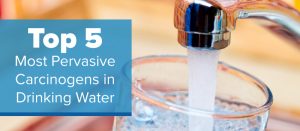
Recent headlines about water quality have grabbed the nation's attention and left many wondering what they can do to protect their homes and families. While there are instances of cancer-causing chemicals in tap water, the good news is that filtration systems can keep chemical water pollution out of your home.
Several carcinogens commonly find their way into tap water. These are largely tasteless and odorless, making them difficult to detect without proper equipment. It is important to know about them for several reasons:
- Health: Your and your family's health can be significantly affected by these carcinogens.
- Applying Pressure on Utility Companies: If you know what carcinogens to look for, you will know what type of pressure to apply on your local utility company to remove them.
Here is some information on the top five cancer-causing agents present in tap water.
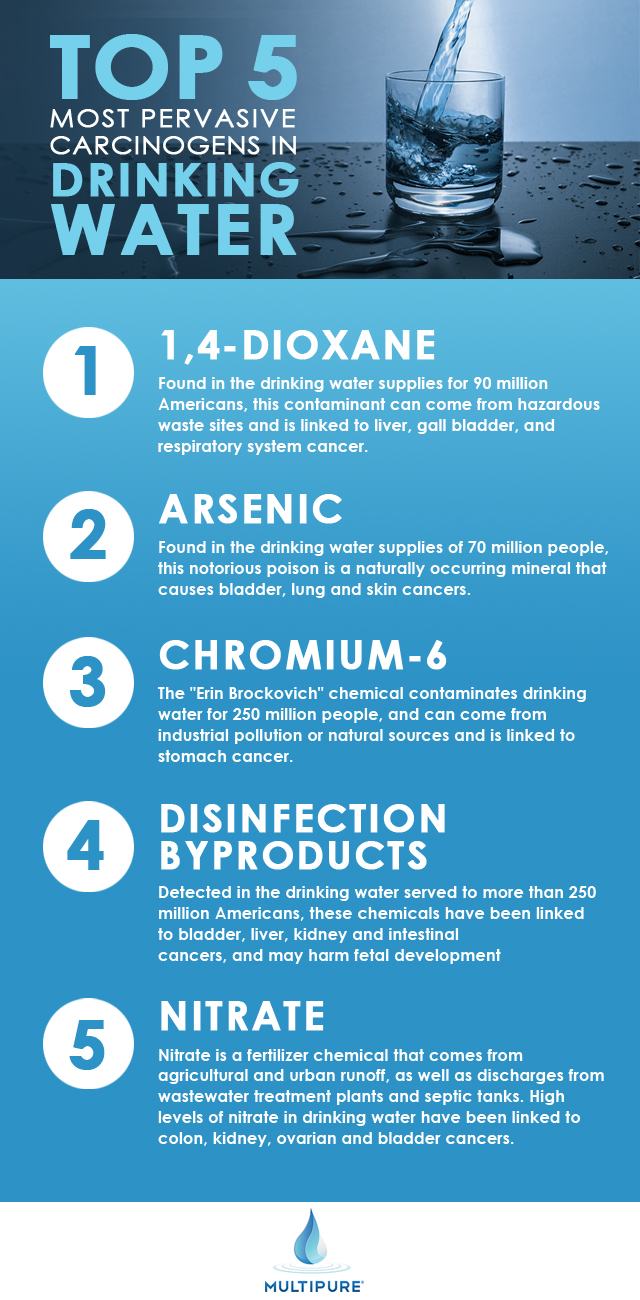
1. 1,4-Dioxane
The chemical known as 1,4-Dioxane has been used as a
stabilizer in industrial applications for over six decades. This compound is also present in inks and adhesives and has been classified as a likely carcinogen to humans. In liquid form, it is clear and has a faintly sweet odor.
It is also present in many shampoos and detergents, where it exists as a byproduct of the manufacturing process. 1,4-Dioxane dissolves completely in water but does not easily break down, causing it to remain as a contaminant for long periods of time.
This carcinogen leaches into the water supply as a result of its use in industry. Though it is more carefully regulated today, it was heavily used for many years and accumulated in landfills. From there, it seeps into the groundwater. Because it blends so easily with water, it moves through soil effortlessly and subsequently reaches surface water. From there, it can cause damage to kidneys and
irritation of the lungs in addition to cancer.
Wastewater treatment plants cannot remove 1,4-Dioxane from water in significant quantities, which makes it especially persistent in surface water. According to the EPA, 1,4-Dioxane at a concentration of 0.35 parts per billion is the amount predicted to lead to a maximum of one case of cancer in a sample of one million people. This level is generally accepted to be the minimum standard for safety.
While 1,4-Dioxane has not been explicitly implicated as a cause of cancer, its administration via drinking water has caused liver cancer in laboratory rats. Consequently, both the International Agency for Research on Cancer and the U.S. Department of Health and Human Services consider it a
likely candidate for causing cancer.
2. Arsenic
Whereas 1,4-Dioxane is a likely carcinogen, arsenic is known to be an especially formidable one. This element occurs naturally in the earth and can be present as deposits in
rocks and other excavations. It also leaches into soil and water as a result of mining refuse, the production of metals and power plants that burn coal and other fossil fuels. Arsenic is a useful n-type doping agent within silicon semiconductors and is used in an ever-shrinking list of consumer products.
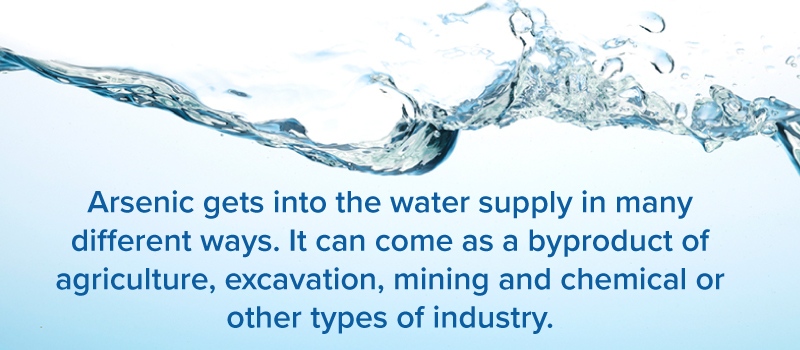
Arsenic gets into the water supply in many different ways. It can come as a byproduct of agriculture, excavation, mining, and chemical or other types of industry. It is present in smoke from tobacco and the smoke from burning pressure-treated lumber. Those who have water delivered by a utility company may find arsenic in their tap water, while those who have dug wells are at risk of naturally-occurring arsenic in their well water.
A 2015 study found that over 70 million Americans had unsafe levels of arsenic in their water. This type of arsenic, known as inorganic arsenic, comes from the ground and is more harmful than the arsenic found in many food products. Because arsenic is always present in our bodies, it is the particular levels that are of concern. When our water contains fewer than 10 parts per billion of arsenic, food becomes the main contributor to our arsenic levels.
Arsenic is associated with many medical ailments:
- Cancer of the bladder, lungs, liver, kidneys, prostate, and skin
- Damages internal organs and leads to cardiovascular diseases
- Interfering with cellular functions
Even the EPA's legal limit of 10 parts per billion is likely too high, as it still contributes 600 cases of cancer to every one million people. More recent EPA research has found arsenic to be 17 times more poisonous than preceding research had indicated, but there is political pressure that may be preventing these findings from coming to light.
3. Chromium-6
Otherwise known as hexavalent chromium, this chemical received its moment in the spotlight with the 2000 film "Erin Brockovich
." Chromium-6 causes cancer even in very small doses, making it a particularly insidious carcinogen and a very present danger in our drinking water. It is used in plenty of industrial processes and products, including dyes for fabrics, preserving wood, preventing corrosion and welding metals like stainless steel.
One frustrating roadblock to keeping chromium-6 out of tap water is that there is currently no safe federal limit. An older study, which limited chromium-6 and chromium-3 to
100 parts per billion, listed the two chemicals as skin irritants. It was later revealed that chromium-6 could cause cancer. When researchers in the EPA completed a new study in 2011, which concluded that chromium-6 was indeed dangerously carcinogenic, the industry applied pressure and its released was postponed. It could still be some time before chromium-6 in drinking water is limited.
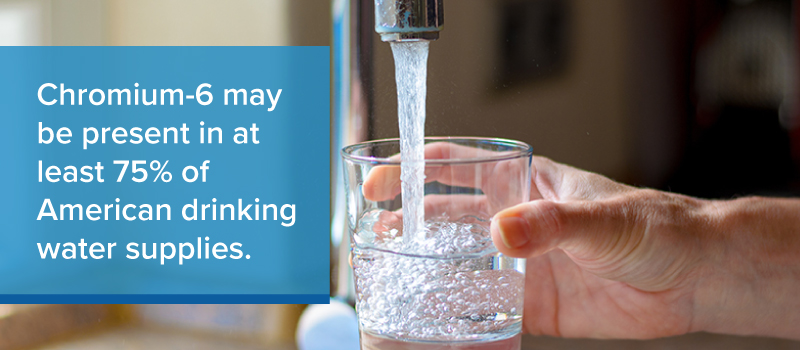
Chromium-6 may be present in at least
75% of American drinking water supplies. It finds its way into them from industrial processes and spills. For instance, a steel plant in Indiana was responsible for a spill that dumped 300 pounds of chromium-6 into a local waterway in 2017. This release of chromium-6 was nearly 600 times the limit allowed by law. Spills aside, the chemical leaches into the water table from industrial processes and runoff.
Chromium-6 causes skin irritation when it is used in tanning leather or other similar products. Ingesting it leads to a host of unwelcome side effects, including liver toxicity, stomach ulcers and irritation, tooth decay and asthma. It is mostly banned within the European Union due to its health hazards.
4. Disinfection Byproducts
Disinfecting water is a massively important process in the modern world and is one of the factors responsible for our ability to distribute drinking water via a grid to large portions of society. Chemicals like chlorine kill potentially deadly disease agents like cholera and dysentery that are a cause of so many deaths in other parts of the world. When chlorine and similar disinfectants combine with waste products from plants and animals in our water system, however, they can form carcinogenic impurities. These are called disinfection byproducts.
Disinfection byproducts lead to a greater risk of cancer and might even cause harm to fetuses. There are
at least 250 million Americans who ingest disinfection byproducts in their drinking water. Dangerous examples include four types of trihalomethanes, five different types of haloacetic acids, bromate and chlorite. However, this is just the set of disinfectant byproducts identified by the government as dangerous — there are hundreds more that have been identified outside of these.
Because disinfection is such a critical part of our infrastructure, it is important to integrate disinfection byproduct removal with our current methods of killing diseases. However, as it stands,
disinfection byproducts find their way into the water as a result of organic waste flowing into reservoirs and mixing with disinfectants.
While the government and utility providers have experimented with different disinfectants to minimize harmful byproducts, the most promising method is preventing organic waste from entering the water system in the first place.
Trihalomethanes and haloacetic acids are the most prevalent disinfectant byproducts in drinking water. These
cause bladder cancer and have led to tumors in the intestines, livers, and kidneys of lab animals. Chlorite can harm thyroid function and sperm as well as cause stomach ulcers. Presently, it appears to be a carcinogen — albeit not a particularly powerful one. Bromate is a disinfectant byproduct that can cause damage to DNA and is the result of the ozonation of water in treatment plants.
5. Nitrate
Nitrate is a carcinogen affecting more than half of the United States' population. Nitrate is present in chemical fertilizers, manure and wastewater effluent from treatment plants. It is extremely common in areas with heavy agriculture and can reside in water wells near livestock or septic tanks. In 1962, the federal government imposed
a limit of 10 milligrams per liter of nitrate, which was sufficient to prevent blue baby syndrome in newborns. However, the limit has not been updated since learning that nitrate is a carcinogen.
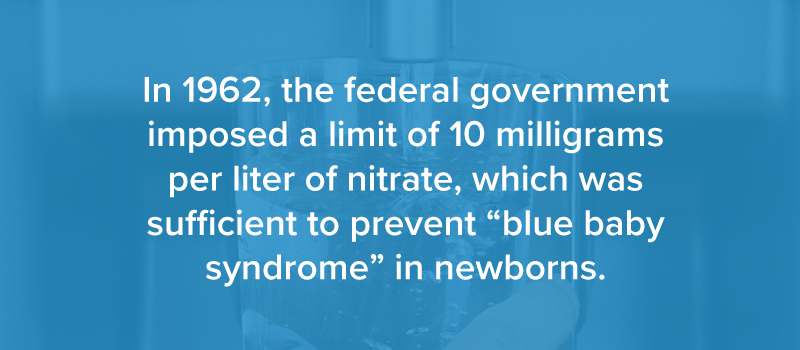
Aside from being a byproduct of agriculture, nitrate also exists naturally in soil. However, this level is greatly increased by the addition of
nitrate-rich fertilizers. When rain falls, it washes much of this nitrate away, carrying it into rivers and the water table. From there, it enters wells, reservoirs, lakes and other sources of water that people use to drink. Nitrate often exists in conjunction with nitrite, which is even more dangerous to humans.
One interesting note about nitrate is its concentration in leafy vegetables. When we consume these, we are also consuming nitrate — though the vegetables also contain enough antioxidants to have a net positive health effect. Tap water remains the other primary source of nitrates and is especially dangerous for infants.
Nitrate leads to methemoglobinemia, or blue baby syndrome, in which a baby's bloodstream is starved of oxygen. Additionally, it leads to thyroid problems and can cause thyroid cancer in women. It harms reproduction and damages DNA, which can lead to cancer in the blood, throat, and other organs.
Despite the mandates of the 1962 limit, it is likely that a lower level of nitrate should be ingested to avoid long-term health effects. Unfortunately, agriculture continues to use more and more fertilizers. This means we will have to find ways to alter agricultural practices to limit the amount of nitrate that runs off fields.
How Do I Know If My Water Contains These Chemicals?
Due to a large amount of interest in public safety, there are several resources to start out with when trying to gauge the
quality of your local water. One of the first places to search is on the EPA's interactive water quality map. By typing in your zip code or city, you can view waterways that are impaired in your area. This allows you to see immediately if the government has identified a water safety issue near you.
Additionally, you can view discharge sites. These are places where industrial concerns dump their waste. If you are downriver from any of these discharge sites, it is a good idea to invest in a water filtration system. Generally, it is a good idea no matter what. If you receive water from a utility company, that water may come from some distance away. If you have a well, there could be chemicals or metals leaching into your well water, and filtration is a great way to ensure your safety.
You can also search for local water providers by going to the Environmental Working Group's
tap water database. Here, you can again type in your zip code and will receive a list of all tap water providers nearby.
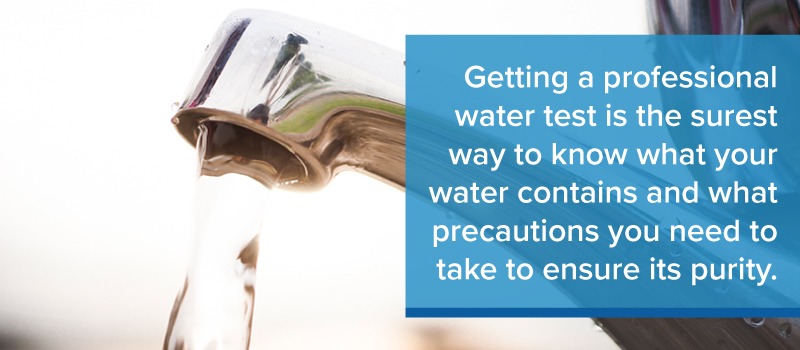
Getting a professional water test is the surest way to know what your water contains and what precautions you need to take to ensure its purity. Contact a local water testing organization to test your tap water.
What Can I Do to Remove These Chemicals From My Drinking Water?
Water filters come in many shapes and sizes to treat drinking water. At Multipure, we offer a broad selection of filtration systems for homes and businesses. Here are some of the products we have to choose from:
- Aqualuxe: Built to offer a combination of artistic beauty and superb functionality, the Aqualuxe is an NSF-certified system that uses carbon block technology to filter out chemicals, viruses, and bacteria from drinking water. It provides peace of mind through industry-leading water filtration performance.
- Aquaversa: This NSF-certified system can be used on a countertop or below the sink. Its carbon block filter treats both aesthetic and health contaminants.
- Aquaperform: This NSF-certified system adds additional media to the carbon block to reduce the amount of Arsenic V in water. It comes in a stainless steel housing and is extremely effective at reducing impurities found in tap water.
Come to Multipure to Taste the Difference
When the safety of the natural environment and your family is on the line, look no further than Multipure to
provide top-of-the-line protection. Our broad range of Solid Carbon Block filters keep carcinogens out of your system and gives you control over the quality of the water in your home. Browse our products today and contact us with any questions.

